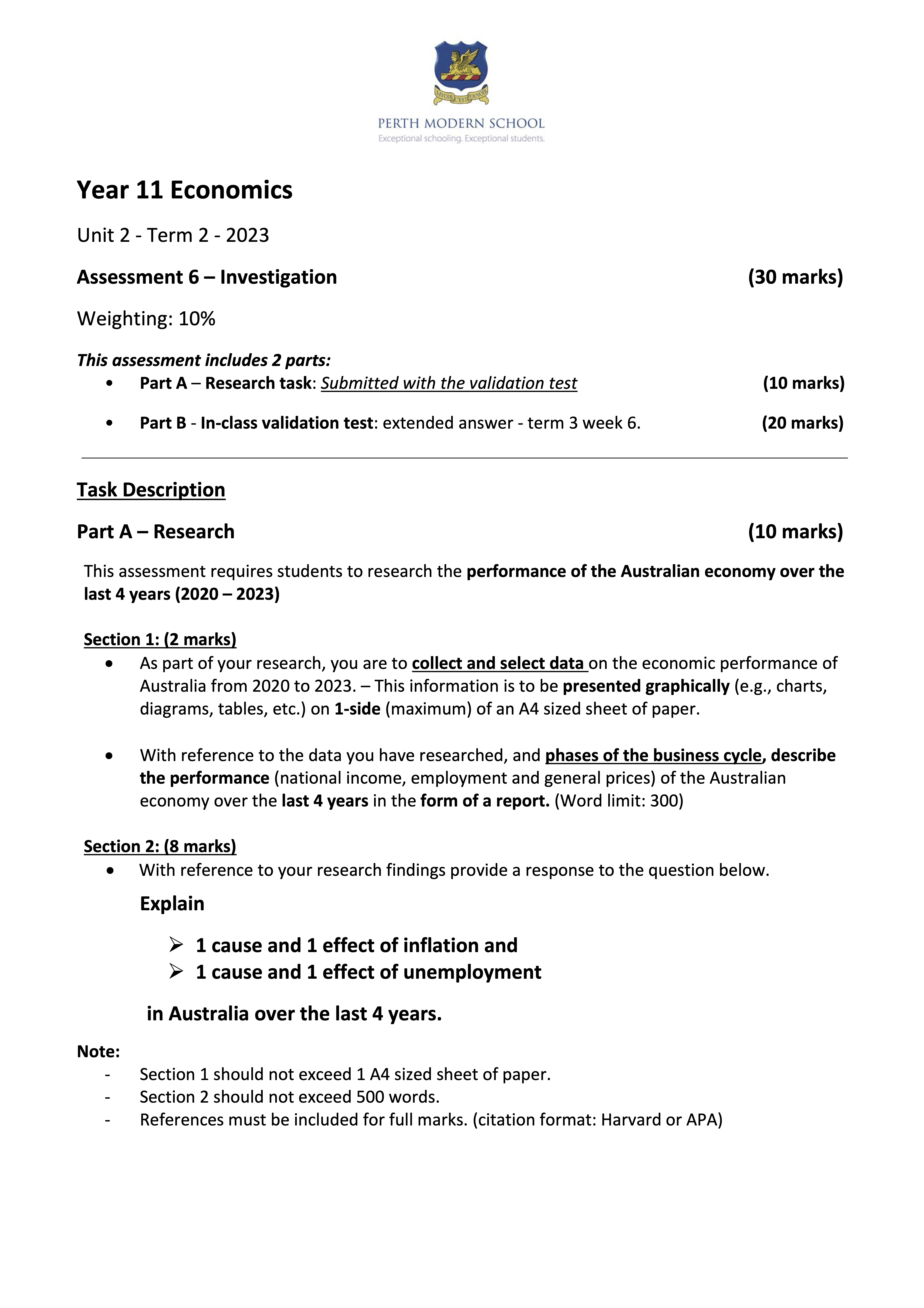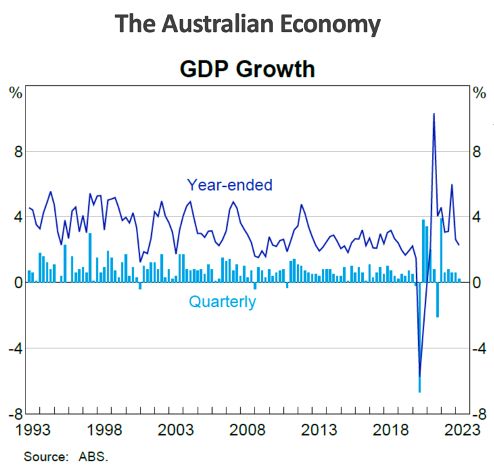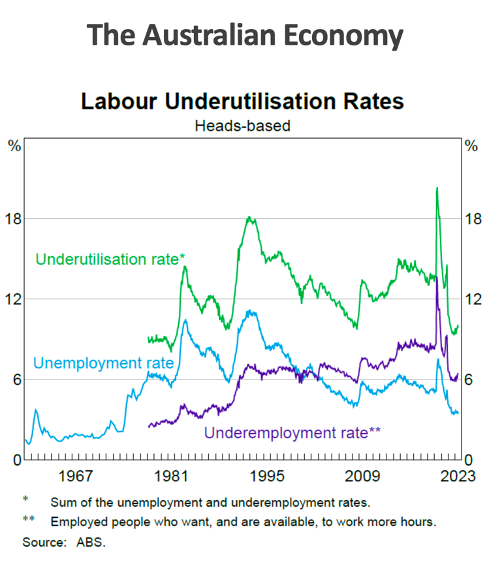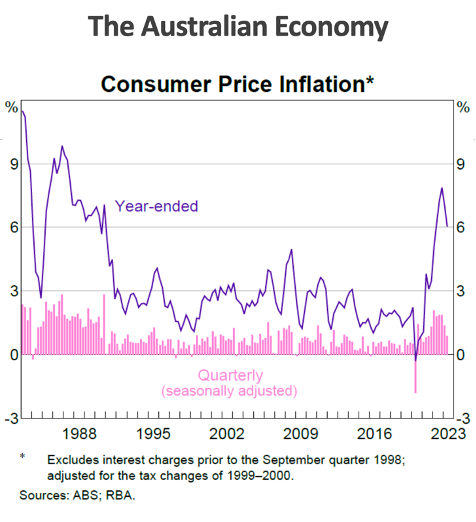
Section 1
Figures
 Figure 1: Australian Economy GDP Growth 1993-2023
Figure 1: Australian Economy GDP Growth 1993-2023
 Figure 2: Australian Economy Labour Underutilisation Rates 1993-2023
Figure 2: Australian Economy Labour Underutilisation Rates 1993-2023
 Figure 3: Australian Economy Consumer Price Inflation 1993-2023
Figure 3: Australian Economy Consumer Price Inflation 1993-2023
Report
The Australian Economy has gone from a trough in 2020 due to the COVID-19(Coronavirus) pandemic, to a peak in 2021, and now is steadily falling, as of 2023. We have been experiencing contractions in economic growth due to our rapid growth after the COVID-19 pandemic.
The RBA goal for economic growth is 3-4% GDP. GDP growth is at a relatively stable BTC but is slowly decreasing over time. In 2020, GDP growth started at approximately 2.2%, but fell to 6% negative GDP growth as seen on figure 1. It started to steadily increase, hitting 4% negative GDP growth at the beginning of 2021, and rising to a peak of 9.5% GDP growth in late 2021. However, it fell to 4% GDP growth in 2022, and has been decreasing as of 2023.
The RBA goal for unemployment rate is 4.5% unemployment rate. The unemployment rate has steadily increased, from a 9% unemployment rate in 2019, before spiking to a new height of 13% unemployment rate in 2020, as can be seen in Figure 2. It can be assumed that this unexpected peak was due to the COVID-19 pandemic. Soon after, however, unemployment rate began to fall, and experience a contraction, in 2021, before reaching a trough at 5.8% in 2023. Currently, according to Figure 2, we are experiencing an increase in unemployment rate.
The RBA goal for price stability is 2-3% CPI. Consumer Price Inflation (CPI) started at 2.3% in 2020, but soon fell and reached a new trough at 0.5% negative CPI, as can be seen in Figure 3. It started to rise in 2021, and reached a peak at 3.5% CPI in mid-2021. It has continued to rise, and reached a peak in 2022 with 7.6% CPI, and has since experienced a contraction, falling to 6% CPI in 2023.
Section 2: Response
Inflation refers to a persistent and appreciable rise in general price levels. One cause of inflation in Australia in the past 4 years would be the Russian invasion of Ukraine over the past year. The cause of inflation is cost pull inflation (rising costs of production are passed onto consumers who pay higher prices for final goods and services), which was caused by the Ukraine War. A graphical representation of this can be seen in Figure 3, where inflation spiked in 2022. A significant contribution to this sudden increase was caused by the Russian Invasion of Ukraine. In protest of this, many countries refused to trade with Russia, and as a result, a supply shock (sudden change in supply of a good or service) occurred, as Russia is a global leading supplier of energy and food. Thus many countries experienced a shortage in said goods. Thus, prices rose, and a sudden increase in CPI (consumer price index, the price of a weighted average market basket of consumer goods and services purchased by households) was caused, leading to a change in inflation. One effect of inflation is its effect on investment. Because inflation can be unpredictable, high inflation rates are often associated with uncertainty about the future. This makes planning difficult, as it has an adverse effect on planned capital investments, that is, the cost of production could be significantly different than predicted. This creates a negative effect on economic growth and productive capacity.
Unemployment is the situation when an individual is able and willing to work, but unable to find work. One cause of unemployment in Australia in the past 4 years would be the COVID-19 pandemic that began in 2020, which caused unemployment in the form of cyclical employment (unemployment due to changes in economic activity). A graphical representation can be seen in Figure 2, where unemployment rate spiked in 2020. Due to COVID-19, Australia was forced to go into a lockdown, which forced many people to work from home, and left many people unemployed. In a parliamentary meeting in 2021, it was confirmed that almost 1 million people were left unemployed in that year. To reduce effects, the government introduced the JobSeeker and JobKeeper initiatives, which is a subsidy providing money to people who lost their jobs due to the sudden lockdown. Furthermore, the government considered including reforms to the childcare subsidy scheme, investment in social housing, and other initiatives such as policies to boost onshore manufacturing and renewable energy projects as sources of job creation, to further reduce the aftereffects of the lockdown. One effect of unemployment is that a loss of income is created for unemployed workers. This is because people who are not employed do not receive an income from a job, and thus they lose potential earnings. Even if they receive unemployment benefits (known colloquially as dole payment), they are more likely to be worse off financially, than if they were employed. As a result, their material standard of living will decrease.
Sources
Aph.gov.au. (2020). Chapter 6. [online] Available at: https://www.aph.gov.au/Parliamentary_Business/Committees/Senate/COVID-19/COVID19/Interim_Report/section?id=committees%2Freportsen%2F024513%2F73988#:~:text=With%20almost%20one%20million%20Australians [Accessed 20 Aug. 2023].
www.deloitte.com. (n.d.). Weekly Economic Briefing: the Ukraine crisis…and its economic impacts on Australia - Economics blog | Deloitte Australia. [online] Available at: https://www.deloitte.com/au/en/services/financial-advisory/perspectives/ukraine-crisis-economic-impacts-australia.html.
RBA (2023). RBA Chart Pack. [online] RBA Chart Pack. Available at: https://www.rba.gov.au/chart-pack/pdf/chart-pack.pdf?v=2023-08-23-18-06-32.
Arce, Ó., Koester, G. and Nickel, C. (2023). One year since Russia’s invasion of Ukraine – the effects on euro area inflation. www.ecb.europa.eu. [online] Available at: https://www.ecb.europa.eu/press/blog/date/2023/html/ecb.blog202302243b75362af3.en.html#::text=The%20war%20triggered%20a%20massive